close
以下資料
來自YAMAHA官網
http://www.yamaha-motor.co.uk/corporate/museum/museum_1955_1969.jsp?active=tcm:46-12108
圖片版權為YAMAHA所有
資料以官方為準
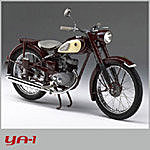
YA-1 1955 (1955)
This was Yamaha’s first motorcycle. At a time when motorcycle design was dominated by imposing all-black styling, the YA-1 with its simple form and modern chestnut red coloring, quickly became popularly known by the nickname “Aka-tombo” (the Red Dragonfly). What’s more, it immediately demonstrated its high performance by winning the 3rd Mt. Fuji Ascent Race in July of 1955, and then swept the top places in the ultra-light class of the 1st Asama Highlands Race of the All Japan Endurance Championships. In an era when the national average starting salary of a male college graduate was 10,780 yen, this model, priced at 138,000 yen, was a coveted extravagance beyond the reach of most users.
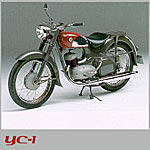
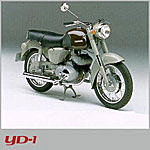
YD-1 1957 (1957)
This is a model born out of a pursuit of design originality. In the development as well, the design elements proceeded the engineering. Taking as its key words “A 250cc for the Japanese,” it was given a compact and easy to ride body size that fit the Japanese physique. What’s more, it embodied a “Dynamic design” that gave the impression of powerful dynamism in any situation. It also mounted Yamaha’s first 2-cylinder engine. In a Japanese market dominated at the time by utility models, the YD-1 brought a new image of sports performance.
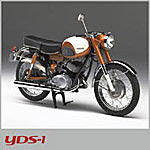
YDS-1 1959 (1959)
Further developing on the sporty performance of the YD-1, this new model mounted a 20hp engine on a steel-pipe cradle frame to achieve unprecedented running performance. Features like the first domestic-made 5-speed transmission and combination type instrument panel with engine tachometer caught the imagination of sports riders, who quickly nicknamed it “Japan’s first sports model.”
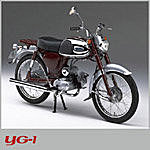
YG-1 1963 (1963)
Mounting a rotary disk valve engine on a backbone type monocoque frame and boasting a number of features like waterproof brakes, a headlight nacelle and a megaphone type muffler, the YG-1 quickly became a popular model and a big hit in sales. With increased engine reliability through improved cooling performance and greater serviceability in the air filter, carburetor and clutch, this model represented a great combination of sportiness and utility.

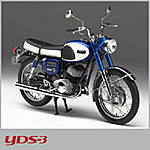
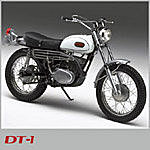
DT-1 1968 (1968)
Winning an unprecedented following from the time of its release, this DT-1 started a worldwide boom in trail bikes. Before the appearance of the DT-1, off-road bikes had been primarily “scrambler” type bikes adapted from on-road models. By contrast, this model was the embodiment of a machine to take you “beyond where the roads end.” Packed full of technologies and features expressly for off-road riding, like a Ceriani type front fork with the longest stroke of any Japanese-made unit at the time, Autolube, a 5-port piston valve engine, wide-radius block-pattern tires and an engine guard, this model created the new genre known as “trail bikes.”
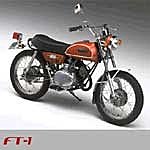
FT-1 (1970)
A pioneer of the “mini-trail” category, the FT-1 mounted a rotary disk valve 2-stroke 50cc engine on a compact chassis. Despite its small displacement, this model boasted features like a full-fledged double-cradle frame, Ceriani front fork and separate meters. Its spirited running performance and full array of features won it solid popularity.
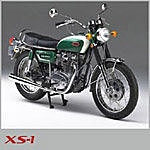
XS-1 (1970)
After making only 2-stroke models for the 15 years since its founding, to the point that its brand name had become synonymous with 2-strokes, Yamaha introduced its first 4-stroke engine on this model, which quickly won a popular following. The goal of building a “lightweight, slim and compact big-displacement sports model,” was achieved by mounting a vertical OHC twin engine characterized mainly by its slimness on a slim double cradle frame.
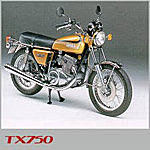
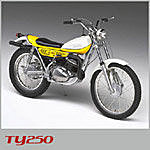
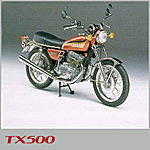

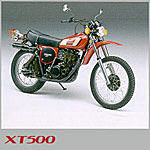
XT500 (1976)
This model was developed as a desert race enduro machine. Released as a street-legal version of the TT500 enduro machine launched the year before, this model became the pioneer of the big single off-road genre. It was the focus of attention also for the bold adoption for the first time ever of a forward inclining upside-down rear suspension on a trail model. It was on an XT500 that the Sonauto Yamaha team’s Cyril Neveu won the motorcycle division of the 1st Paris Dakar Rally in 1979.
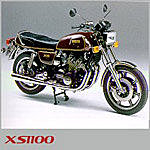
XS1100 (1977)
An export-only model that ushered in the over-one-liter era. The DOHC in-line 4-cylinder 1102cc engine’s awesome power created new excitement among European and American enthusiasts. The rear wheel was shaft-driven. A European version with continental handlebars and an oil cooler as well as an American version with up-slanted handlebars were available.
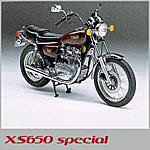
XS650 Special (1978)
This model was the one that set the fire under a boom in American style bikes based on the traditional vertical twin engine of the TX650. With features like a teardrop tank, and chopper style handlebars along with a King & Queen seat and short megaphone type muffler, all mounted on 16-inch wheels, this model achieved a true horseback type riding feeling. As the predecessor to the Special series bikes to follow, this model was popular both for long-distance touring and around-town riding.
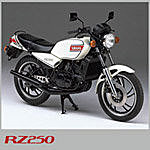
RZ-250 (1980)
This was a supersport model developed with the TZ250 as its base. It immediately created a big sensation after its stunning debut at the 1979 Tokyo Motor Show. Its liquid-cooled 2-stroke, 2-cylinder engine pumped out high power equivalent to 140 hp per liter of displacement. This was mounted on a double cradle frame with a Monocross suspension and other features like lightweight cast wheels to produce unprecedented running performance. Even today it remains a legendary model with a devoted following.
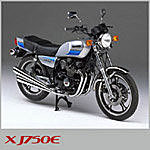
XJ-750E (1981)
One of the models that embodied perhaps better than many others Yamaha’s ideal of building motorcycles that are “slim, compact and fun to ride” was the XJ750E. By locating the generator on the back side of the cylinders in an air-cooled 4-stroke DOHC in-line format, produced an engine that was exceptionally slim. This was an astonishing feat for a 4-cylinder 750cc, and it won the admiration of fans as a highly controllable 750
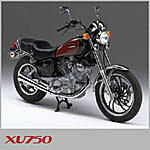
XV-750 Special (1981)
This American-style model mounted a newly developed 75-degree V-twin engine characterized by a sense of powerful torque that accentuated the solid American type ride. Also, adopting features like the first Monocross suspension in its class and shaft drive, it achieved higher levels of function and reliability as well. For these reasons this model won an especially strong reputation in overseas markets where longer riding distances are common.
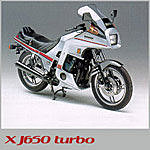
XJ-650 Turbo (1982)
With its world’s first carburetor turbo system, the XJ650 Turbo was quick to draw attention at the 1981 Tokyo Motor Show. This, added to the introduction of the electronic fuel injection turbo system on the XJ1100 Turbo, focused much attention on Yamaha’s turbo technology. The aerodynamically designed full faring was the product of repeated wind-tunnel tests and employed much of the modeling technology and know-how from Yamaha’s marine division.
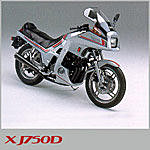
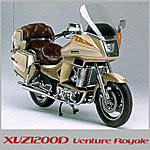
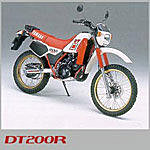
DT-200R (1984)
This “Super Trail” model brought the mechanics, performance and even the image of Yamaha’s YZ motocrossers to a street-legal vehicle for the first time. Its 2-stroke liquid-cooled single-cylinder engine was the first to adopt both the YEIS and YPVS technologies on its engine, achieving a high power output of 30 horsepower. In the front it sported a disc brake system designed specifically for offroad use.
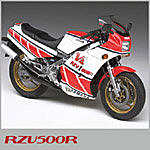

FZ-750 (1985)
The FZ750 was quick to draw attention at the Cologne motor show in Germany in the autumn of 1984. Its world's first 5-valve DOHC parallel 4-cylinder, 45-degree forward-inclined engine, was the product of Yamahaユs pursuit of increased power output and vehicle stability. This “Genesis” concept has been passed on from the FZ to the FZR, and still continues to evolve.

SRX-600 (1985)
With its simple and Spartan styling, its lightweight, slim and compact body, the appealing presence of its mechanical features, and the pulse and riding feel unique to the big single, this model represented a tasteful Super Sports motorcycle for people who sought a profound motorcycling experience. Its SOHC 4-valve, single-cylinder engine adopted the YDIS system.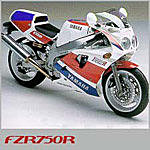
來自YAMAHA官網
http://www.yamaha-motor.co.uk/corporate/museum/museum_1955_1969.jsp?active=tcm:46-12108
圖片版權為YAMAHA所有
資料以官方為準

YA-1 1955 (1955)
This was Yamaha’s first motorcycle. At a time when motorcycle design was dominated by imposing all-black styling, the YA-1 with its simple form and modern chestnut red coloring, quickly became popularly known by the nickname “Aka-tombo” (the Red Dragonfly). What’s more, it immediately demonstrated its high performance by winning the 3rd Mt. Fuji Ascent Race in July of 1955, and then swept the top places in the ultra-light class of the 1st Asama Highlands Race of the All Japan Endurance Championships. In an era when the national average starting salary of a male college graduate was 10,780 yen, this model, priced at 138,000 yen, was a coveted extravagance beyond the reach of most users.
- 'Overall length x width x height: 1,980mm x 660mm x 925mm
- Weight: 94kg
- Engine-type: Air-cooled 2-stroke 1-cylinder 123cc
- Maximum power output: 5.6ps/5,000rpm
- Maximum torque: 0.96kg-m/3,300rpm

| YC-1 1956 (1956) A deluxe version of the YA-1, this model immediately drew public attention when it appeared at the Tokyo Motor Show held in Hibiya Park in April of 1956. With a grayish-brown finish, taking its image from the wet pavement of the Champs-Elysees, this model represented a high-level marriage of design and function with features like the first domestic-made monobloc carburetor. This immediately boosted the brand image of Yamaha, a company that was still at the time, a latecomer to the Japanese motorcycle industry.
|

YD-1 1957 (1957)
This is a model born out of a pursuit of design originality. In the development as well, the design elements proceeded the engineering. Taking as its key words “A 250cc for the Japanese,” it was given a compact and easy to ride body size that fit the Japanese physique. What’s more, it embodied a “Dynamic design” that gave the impression of powerful dynamism in any situation. It also mounted Yamaha’s first 2-cylinder engine. In a Japanese market dominated at the time by utility models, the YD-1 brought a new image of sports performance.
- 'Overall length x width x height: 1,935mm x 705mm x 935mm
- Weight: 140kg
- Engine-type: Air-cooled 2-stroke 2-cylinder 247cc
- Maximum power output: 14.7ps/6,000rpm
- Maximum torque: 1.9kg-m/4,000rpm

YDS-1 1959 (1959)
Further developing on the sporty performance of the YD-1, this new model mounted a 20hp engine on a steel-pipe cradle frame to achieve unprecedented running performance. Features like the first domestic-made 5-speed transmission and combination type instrument panel with engine tachometer caught the imagination of sports riders, who quickly nicknamed it “Japan’s first sports model.”
- 'Overall length x width x height: 1,990mm x 615mm x 950mm
- Weight: 138kg
- Engine-type: Air-cooled 2-stroke 2-cylinder 246cc
- Maximum power output: 20ps/7,500rpm
- Maximum torque: 1.9kg-m/6,000rpm

YG-1 1963 (1963)
Mounting a rotary disk valve engine on a backbone type monocoque frame and boasting a number of features like waterproof brakes, a headlight nacelle and a megaphone type muffler, the YG-1 quickly became a popular model and a big hit in sales. With increased engine reliability through improved cooling performance and greater serviceability in the air filter, carburetor and clutch, this model represented a great combination of sportiness and utility.
- 'Overall length x width x height: 1,815mm x 625mm x 960mm
- Weight: 82kg
- Engine-type: Air-cooled Rotary disk valve 1-cylinder 75cc
- Maximum power output: 6.5ps/7,000rpm
- Maximum torque: 0.7kg-m/5,000rpm

| AT90 1965 (1965) This model appeared as a dual-purpose bike that combined business utility with sportiness. Mounting a small-displacement high-rpm type 90cc twin cylinder engine known as the “jet twin,” this model became especially popular among sports-minded riders. The “AT” in its name came from its Autolube lubrication system. This forced lubrication mechanism achieved both high performance and low fuel consumption as well as good utility.
|

| YDS-3 1966 (1966) Yamaha’s YDS series had evolved steadily from the YDS-1 introduced in 1959 through the YDS-2 of ’62 and then this YDS-3. One of the foremost Japanese sports models, it also won great popularity in the USA. As the first 2-cylinder model to adopt the Autolube system, it achieved unchallenged reliability and high-speed durability. Also adopting features like a 3-step adjustable shock absorber, this model represented a high-level marriage of engine performance, running performance and utility.
|

DT-1 1968 (1968)
Winning an unprecedented following from the time of its release, this DT-1 started a worldwide boom in trail bikes. Before the appearance of the DT-1, off-road bikes had been primarily “scrambler” type bikes adapted from on-road models. By contrast, this model was the embodiment of a machine to take you “beyond where the roads end.” Packed full of technologies and features expressly for off-road riding, like a Ceriani type front fork with the longest stroke of any Japanese-made unit at the time, Autolube, a 5-port piston valve engine, wide-radius block-pattern tires and an engine guard, this model created the new genre known as “trail bikes.”
- 'Overall length x width x height: 2,060mm x 890mm x 1,130mm
- Weight: 112kg
- Engine-type: Air-cooled Piston valve 1-cylinder 246cc
- Maximum power output: 18.5ps/6,000rpm
- Maximum torque: 2.32kg-m/5,000rpm

FT-1 (1970)
A pioneer of the “mini-trail” category, the FT-1 mounted a rotary disk valve 2-stroke 50cc engine on a compact chassis. Despite its small displacement, this model boasted features like a full-fledged double-cradle frame, Ceriani front fork and separate meters. Its spirited running performance and full array of features won it solid popularity.
- 'Overall length x width x height: 1.585mm x 700mm x 930mm
- Weight: 59kg
- Engine-type: Air-cooled Rotary disk valve 2-stroke 1-cylinder 49cc
- Maximum power output: 4.0ps/7,500rpm
- Maximum torque: 2.52kg-m/6,000rp

XS-1 (1970)
After making only 2-stroke models for the 15 years since its founding, to the point that its brand name had become synonymous with 2-strokes, Yamaha introduced its first 4-stroke engine on this model, which quickly won a popular following. The goal of building a “lightweight, slim and compact big-displacement sports model,” was achieved by mounting a vertical OHC twin engine characterized mainly by its slimness on a slim double cradle frame.
- 'Overall length x width x height: 2,175mm x 905mm x 1,115mm
- Weight: 185kg
- Engine-type: Air-cooled 4-stroke OHC 2-cylinder 653cc
- Maximum power output: 53ps/7,000rpm
- Maximum torque: 5.5kg-m/6,000rpm

| TX750 (1972) Yamaha’s first production 750cc model sold on the market. In a time when multi-cylinder engines were most common in the bigger 4-stroke road sports models, Yamaha exhibited its originality with features such as an SOHC vertical in-line 2-cylinder engine with balancer that had a big twin’s unique sense of torque and pulse, as well as a slim body for nimble handling. Its advanced mechanics included such as a anti-vibration structure which was a first for a motorcycle, dry sump lubrication, opposed-piston type double disc brakes and the first aluminum frame ever on a street model.
|

| TY250 (1973) Yamaha developed the TY250 as a competition model at a time when trial competition was booming. Mic “the Magician” Andrews was one of the riders involved in the development. The TY250J was released as a model that could also be ridden on public roads. With its 250cc engine known for flat torque characteristics and solid low-speed-range torque so strong that the machine would move forward even at idle, its slim body and fat rear tire, this model’s pedigree as a trial machine was beyond question. Its many records in competition speak for themselves.
|

| TX500 (1973) The third model of Yamaha’s 4-stroke road sports category, this racy Super Sports model was, very different from its predecessors, the 650 and 750, being the first road bike to have a DOHC 4-valve per cylinder high output engine. Functions such as the worldユs first IC regulator, a CV carburetor, an aluminum frame and front disc brakes were also featured on this model.
|

| GX750 (1976) This model embodied a high-level marriage of comfort when cruising on the expressway, running stability and the kind of spirited riding feel that customers wanted in a motorcycle. In the quest for high performance, high durability and high reliability, this model adopted unique Yamaha technologies in features like its compact, laterally-aligned DOHC 3-cylinder engine and a maintenance-free shaft drive. The next year the GX750II was introduced with a 3 into 2 muffler and a big boost in power up to 67 ps.
|

XT500 (1976)
This model was developed as a desert race enduro machine. Released as a street-legal version of the TT500 enduro machine launched the year before, this model became the pioneer of the big single off-road genre. It was the focus of attention also for the bold adoption for the first time ever of a forward inclining upside-down rear suspension on a trail model. It was on an XT500 that the Sonauto Yamaha team’s Cyril Neveu won the motorcycle division of the 1st Paris Dakar Rally in 1979.
- 'Overall length x width x height: 2,170mm x 875mm x 1,180mm
- Weight: 139kg
- Engine-type: Air-cooled 4-stroke OHC 1-cylinder 499cc
- Maximum power output: 30ps/5,800rpm
- Maximum torque: 3.9kg-m/5,400rpm

XS1100 (1977)
An export-only model that ushered in the over-one-liter era. The DOHC in-line 4-cylinder 1102cc engine’s awesome power created new excitement among European and American enthusiasts. The rear wheel was shaft-driven. A European version with continental handlebars and an oil cooler as well as an American version with up-slanted handlebars were available.
- 'Overall length x width x height: 2260mm x 920mm x 1175mm
- Weight: 222kg
- Engine-type: Air-cooled 4-stroke DOHC 4-cylinder 1102cc
- Maximum power output: 95ps/8000rpm
- Maximum torque: 9.2kg-m/6500rpm

XS650 Special (1978)
This model was the one that set the fire under a boom in American style bikes based on the traditional vertical twin engine of the TX650. With features like a teardrop tank, and chopper style handlebars along with a King & Queen seat and short megaphone type muffler, all mounted on 16-inch wheels, this model achieved a true horseback type riding feeling. As the predecessor to the Special series bikes to follow, this model was popular both for long-distance touring and around-town riding.
- 'Overall length x width x height: 2,130mm x 930mm x 1,255mm
- Weight: 205kg
- Engine-type: Air-cooled 4-stroke SOHC 2-cylinder 653cc
- Maximum power output: 51ps/7,500rpm
- Maximum torque: 5.4kg-m/5,500rpm

RZ-250 (1980)
This was a supersport model developed with the TZ250 as its base. It immediately created a big sensation after its stunning debut at the 1979 Tokyo Motor Show. Its liquid-cooled 2-stroke, 2-cylinder engine pumped out high power equivalent to 140 hp per liter of displacement. This was mounted on a double cradle frame with a Monocross suspension and other features like lightweight cast wheels to produce unprecedented running performance. Even today it remains a legendary model with a devoted following.
- 'Overall length x width x height: 2,080mm x 740mm x 1,085mm
- Weight: 139kg
- Engine-type: Liquid-cooled 2-stroke 2-cylinder 247cc
- Maximum power output: 35ps/8,000rpm
- Maximum torque: 3.0kg-m/8,000rpm

XJ-750E (1981)
One of the models that embodied perhaps better than many others Yamaha’s ideal of building motorcycles that are “slim, compact and fun to ride” was the XJ750E. By locating the generator on the back side of the cylinders in an air-cooled 4-stroke DOHC in-line format, produced an engine that was exceptionally slim. This was an astonishing feat for a 4-cylinder 750cc, and it won the admiration of fans as a highly controllable 750
- 'Overall length x width x height: 2,175mm x 725mm x 1,135mm
- Weight: 214kg
- Engine-type: Air-cooled 4-stroke DOHC 4-cylinder 748cc
- Maximum power output: 70ps/9,000rpm
- Maximum torque: 6.2kg-m/7,000rpm

XV-750 Special (1981)
This American-style model mounted a newly developed 75-degree V-twin engine characterized by a sense of powerful torque that accentuated the solid American type ride. Also, adopting features like the first Monocross suspension in its class and shaft drive, it achieved higher levels of function and reliability as well. For these reasons this model won an especially strong reputation in overseas markets where longer riding distances are common.
- 'Overall length x width x height: 2,240mm x 805mm x 1,160mm
- Weight: 212kg
- Engine-type: Air-cooled 4-stroke OHC V-type 2-cylinder 748cc
- Maximum power output: 60ps/7,000rpm
- Maximum torque: 6.4kg-m/6,000rpm

XJ-650 Turbo (1982)
With its world’s first carburetor turbo system, the XJ650 Turbo was quick to draw attention at the 1981 Tokyo Motor Show. This, added to the introduction of the electronic fuel injection turbo system on the XJ1100 Turbo, focused much attention on Yamaha’s turbo technology. The aerodynamically designed full faring was the product of repeated wind-tunnel tests and employed much of the modeling technology and know-how from Yamaha’s marine division.
- 'Overall length x width x height: 2,200mm X 730mm X 1,355mm
- Weight: 230kg
- Engine-type: Air-cooled 4-strokeDOHC 4-cylinder 653cc
- Maximum power output: 90ps/9,000rpm
- Maximum torque: 8.33kg-m/7,000rpm

| XJ-750D (1982) The XJ750D was the first model in Japan equipped with a full faring incorporating aerodynamic design. At the same time it featured advanced Yamaha electronic technologies such as the YFIS (Yamaha Fuel Injection System) and the “Yamaha Cycle Communication System,” which provided a man-machine interface to give the rider information concerning the condition of the machine.
|

| XVZ-1200D Venture Royale (1983) The Venture Royale was, in 1983, the Yamaha motorcycle with the largest displacement and power output, and it was developed as a long-distance tourer for the North American market. A liquid-cooled DOHC 4-valve 70 degree V-4 engine and shaft drive for the power unit and full comfort measures including computer controlled front and rear suspension system, made this model great for comfortable long-distance cruising.
|

DT-200R (1984)
This “Super Trail” model brought the mechanics, performance and even the image of Yamaha’s YZ motocrossers to a street-legal vehicle for the first time. Its 2-stroke liquid-cooled single-cylinder engine was the first to adopt both the YEIS and YPVS technologies on its engine, achieving a high power output of 30 horsepower. In the front it sported a disc brake system designed specifically for offroad use.
- 'Overall length x width x height: 2,150 mm x 820mm x 1,190mm
- Weight: 99kg
- Engine-type: Liquid-cooled 2-stroke single-cylinder 195cc
- Maximum power output: 30ps/8,500rpm
- Maximum torque: 2.6kg-m/7,500rpm

| RZV-500R (1984) This was the world’s first production model to mount a liquid-cooled 2-stroke V-4 engine. As the flagship model embodying Yamaha’s sports spirit and also as the fastest road-going model of its day, the RZV500 stood proudly above the rest. It was the direct descendent of the YZR500 works machine that Kenny Roberts rode to the championship title with six wins in the 12 rounds of the 1983 World GP. The engine boasted new advances in 2-stroke technology like giving the forward and rear banks of cylinders different induction systems; piston reed valve in front and crankcase reed valve in the rear.
|

FZ-750 (1985)
The FZ750 was quick to draw attention at the Cologne motor show in Germany in the autumn of 1984. Its world's first 5-valve DOHC parallel 4-cylinder, 45-degree forward-inclined engine, was the product of Yamahaユs pursuit of increased power output and vehicle stability. This “Genesis” concept has been passed on from the FZ to the FZR, and still continues to evolve.
- 'Overall length x width x height: 2,225mm X 755mm X 1,165mm
- Weight: 209kg
- Engine-type: Liquid-cooled 4-stroke DOHC 5-valve 4-cylinder 749cc
- Maximum power output: 77ps/9,500rpm
- Maximum torque: 7.0 kg-m/6,500rpm

SRX-600 (1985)
With its simple and Spartan styling, its lightweight, slim and compact body, the appealing presence of its mechanical features, and the pulse and riding feel unique to the big single, this model represented a tasteful Super Sports motorcycle for people who sought a profound motorcycling experience. Its SOHC 4-valve, single-cylinder engine adopted the YDIS system.
- 'Overall length x width x height: 2,085mm x 705mm x 1,055mm
- Weight: 149kg
- Engine-type: Air-cooled 4-stroke SOHC 4-valve single-cylinder 608cc
- Maximum power output: 42ps/6,500rpm
- Maximum torque: 4.9kg-m/5,500rpm

| FZR-750R (1989) Inheriting the “OW” in-house designation for Yamaha’s factory machines for its nickname, the FZR750R was a production model with many features fed back directly from the Yamaha YZF750 works machine that competed in the TT-F1 4-stroke road racing class. It was a full-fledged works replica with a DOHC 5-valve, parallel 4-cylinder engine with titanium connecting rods.

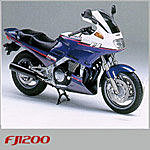
 GTS 1000A (1993) Packed full of the most advanced technologies, the GTS1000 made its debut in 1992 as a new-generation sports tourer that achieved a fine balance of qualities that enabled enjoyment of both serious sports riding and comfortable touring. The liquid-cooled DOHC 5-valve parallel 4-cylinder 1000cc engine featured electronic fuel injection and a 3 Way catalyzer for cleaner emissions. Also, a newly developed omega-shaped aluminum frame and a front wheel assembly separated steering function and suspension function greatly improved handling stability.
|
全站熱搜


 留言列表
留言列表